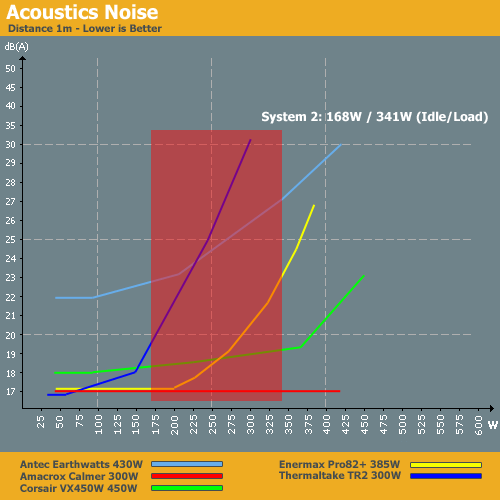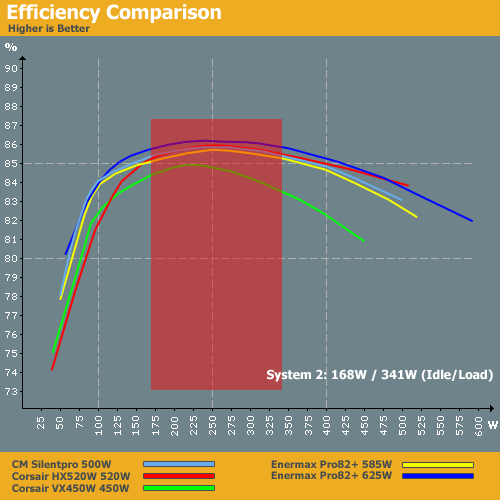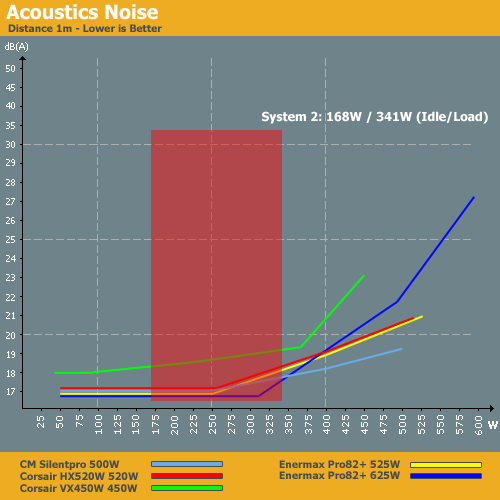Debunking Power Supply Myths
by Christoph Katzer on September 22, 2008 3:00 AM EST- Posted in
- Cases/Cooling/PSUs
PSUs for Midrange Systems
Our midrange system opens up a lot more in the way of potential power supplies, as there are far more manufacturers building 400W to 500W PSUs. Our idle power consumption in this case is 168W, which is quite high when compared to the 120W a high-end system would have used a few years back (i.e. AMD Athlon 64 4000+ and NVIDIA GeForce 7800 GTX under full load). However, times change and we see increased power requirements along with performance improvements.
Our selection of power supplies uses the same criteria as before. We will also see how our entry-level power supplies and all this sort of system.
- Cooler Master Silent Pro (500W) actively cooled
- Corsair HX520W (520W) actively cooled
- Corsair VX450W (450W) actively cooled
- Enermax Pro82+ (585W) actively cooled
- Enermax Pro82+ (625W) actively cooled


In terms of efficiency as well as the ability to supply sufficient power, all of the power supplies are able to run this midrange setup except for the 300W Thermaltake unit. The Antec Earthwatts has been around for a while, so it's not surprising that it doesn't perform as well as newer models, but it still delivers decent if not great efficiency. Noise levels are a different matter, and we would be inclined to avoid most of the entry-level PSUs. If noise isn't a consideration, all but the Antec will work; however, the Corsair VX450W performs best out of these units in so we will carry it along to the next level and include it with the midrange offerings.
Efficiency is Not the Issue

With the addition of some higher performing power supplies, efficiency clearly shouldn't be the overriding concern for a computer like our midrange system. The Corsair VX450W doesn't look as good in this graph, although 83% efficiency certainly isn't anything to cry about. The newer models all reach efficiency of around 85% to 86% throughout the midrange system load. Comparing the two scenarios, outside of PSUs that simply can't provide enough power it's not necessary to move up to a higher performance power supply. You want to look at other aspects such as features, warranty, and noise levels before making a decision.

In terms of noise levels, all of these units perform very well and can provide a quiet computing environment. We also see a clear separation between the entry-level PSUs in the midrange PSUs in this chart, since the midrange units are running a 75% load at worst. Again, if you've had the mindset that 600W and higher PSUs are required for modern midrange systems, the above charts should help dispel that myth. If you can find a good quality 400W PSU, it can easily power a midrange system. However, 500W PSUs generally make the best fit, as they provide optimal efficiency and lower noise.










98 Comments
View All Comments
LTG - Monday, September 22, 2008 - link
You can't just look at the TDP's, that's the problem.When you overclock the power demands can increase in a very non-linear way.
So for example I can't plan for one of the most popular 280 cards like the EVGA FTW 280 GTX. It's 11% core over clocked, what does that mean at the outlet? No good way to guess.
Same for a 3.6Ghz QC CPU - this is a very common overclock, yet there is no direct way to know it's power requirements.
I'm just saying this is not esoteric information, this would be data people really could use and can't get from the manufacturer.
xaris106 - Friday, November 7, 2008 - link
But you can. All you need is stock power consumption at load(Pstock), stock voltage(Vstock) and stock frequency(Fstock) The oc power is then:Poc = Pstock * (Foc/Fstock) * (Voc/Vstock)^2
nubie - Monday, September 22, 2008 - link
Unless they edited this, you are operating on a false assumption.(Unfortunately, our power supply testing labs didn't have the latest GPUs available for testing.)
A power supply testing lab doesn't need to have every component on hand because it uses a test bench to load the supplies.
Great article, way to dispel myths, I guess since I only plan to overclock with a single video card and one or two hard drives my PCPower Silencer 470 will be enough power for many years to come (which is what I hoped when I bought it, the only downside is the single 6-pin for the video card, when it can clearly handle much more.)
JarredWalton - Monday, September 22, 2008 - link
Just for the curious, AnandTech staff is scattered far and wide around the globe (well, at least the US and Europe). I'm west coast, Wes is east coast, Anand and Derek are in NC, Gary is in TX, and we have Johan and Liz in Belgium with Christoph in France. (That's not everyone, but you get the point.) Since we tend to focus on our own areas of testing, Derek and Anand have the most CPU/GPU hardware, I have laptops and displays, Gary has motherboards, etc. I can definitely say that Christoph isn't the only one without 48x0 and GTX 2x0 hardware. [Pardon me while I go cry in a corner now....]hyvonen - Wednesday, June 3, 2009 - link
Oh, so in order to get this power draw info on more components, I should beg Anand? :)LTG - Monday, September 22, 2008 - link
Totally understood, many companies now days are distributed and can't have every physical resource available to every person.However I would volunteer to send Christof a new 280 GTX to test if he decides it's worth it.
Serious - Just please send it back whenever finished :). And I waive all claims if it is accidentally fried by that fancy Chroma thingy.
ineedaname - Tuesday, November 2, 2010 - link
This article is well written and tried to put real life numbers and situations to the test on PSUs.However i felt that they should mention one other thing for people who are novice to computers. They should mention that just because a PSU is rated for 500w it doesn't necessarily mean that it will do the job even if your computer will only suck about 150w max. Because a 500w psu that comes along with a $50 case just won't do the job. Not because of the wattage rating but because they use crappy parts and workmanship; it'll just die in 3 months when the warranty is over.
gsuburban - Saturday, November 11, 2017 - link
This article was written in 2008. It would be great if it were updated with the more modern CPU's and Motherboards/Chipsets. Many experts suggest most systems don't need more than 400 watts as long as the PSU is a quality make.This would be a great addition with more modern hardware especially now that we have SSD's and M.2 hard drives.